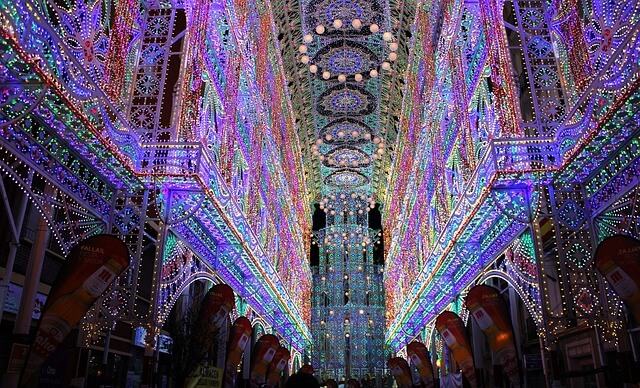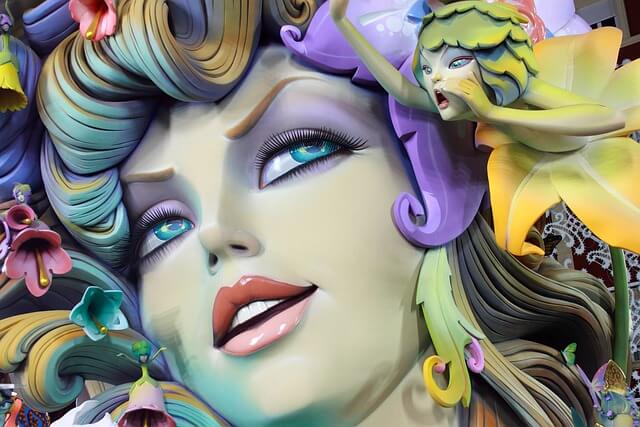The Fallas Festival in Valencia, Spain
A Celebration of the Rebirth of Spring
by Carla Waldemar
 |
| An light installation at the spring festival in Valencia, Spain. |
Spain is a land of vivid festivals, and its people, warm and generous by nature and nurture, welcome visitors to their many celebrations. Pamplona’s running of the bulls draws multitudes of visitors; it’s the most-attended celebration in the land.
Quick: What’s number two?
Valencia claims that honor with its annual Fallas week, March 12-19 (many parts of the festivities continue from March 1). The sunny city of 800,000 swells to twice that size during Fallas week, attracting families from all of Spain — but the word has yet to spread to many foreigners. It’s like Mardi Gras to the hundredth power — a centuries-old celebration of the end of winter’s darkness and the rebirth of spring.
Fallas are elaborate, colorful assemblies of figures — like a stationary Mardi Gras float — constructed of papier mache on timber frames up to 30 meters high. They have a satirical, cartoon-like slant, caricaturing political figures, celebrities, or the hottest issues of the day.
 |
|
A fallas scupture in Valencia.
|
Each neighborhood forms a fallas association to choose a theme, design and construct the displays, and select its queen. Over 400 of these fantasies dot the city’s intersections, drawing crowds to ogle them until the final day, March 19, when at midnight, all areas are set afire (save one, voted the best, which ends up in the Fallas Museum), and it’s over for another year.
Valencia claims to be the fireworks capital of the world, and having just returned from this year’s Fallas week, I’ll testify to the truth of that boast. All week long, at 2 p.m. in the main square, a mascleta takes place — basically, a grand excuse to shoot off gunpowder for 15 minutes nonstop — 130 kilos of it daily, along with daylight fireworks displays. It’s deafening. And the crowd loves it. The minute it’s finished, each neighborhood fallas ignites its own volley. People gather an hour in advance to witness the daily barrage, and all week long, streets in the historic center are closed to traffic. To add to the aural assault, individual falleros (participants) light and toss their own firecrackers 24/7.
The most beautiful part of Fallas Week is the parades on March 17 and 18, called l’ofrenas, the offerings. Each neighborhood fallera group joins processions throughout the city en route to the Plaza de la Virgin. Ladies are dressed in elaborate traditional costumes with full skirts of brocade, lacy aprons and mantillas, ribbons, sashes, and jewels. Their hair, strictly parted in the middle, is coiled into braids over each ear, fastened with golden pins and combs. Every lady carries a bouquet of carnations. Their menfolk also march in quiet ranks, garbed in tight trousers or short peasant skirts, cloth sandals, and kerchiefs atop their heads; they’re pushing strollers or carrying tiny babies on their chests, each small head swathed in a scarf or mantilla, too. Enlivening the paraders is each fallas’ marching band, pumping out rhythmic tunes like “Valencia” (which still echoes in my head).
In the plaza in front of the basilica dedicated to the Virgin, a vast, teepee-like wooden frame has been built, topped with the Virgin’s head. Like rapellers on a cliff, men are stationed on this frame to catch bouquets from the marchers and assemble them to form a floral skirt for the Madonna. It stays there to ogle for days, until the petals fall.
Throughout the week, spectacular fireworks displays and many more firecrackers light the skies at midnight. Street dances and paella cooking contests surrounding each falla continue until dawn. Then, on March 19, two evening parades vie for your attention.
The Moors and Christians version awes spectators with fine costumes, turbans, and all, and camels in their midst. Meanwhile, the Parade of Fire is going on, composed of troupes of red-costumed devils, exotic African-style dancers, drumming units, and antic fellows spraying starry fireworks from hoses at the sky (and, truth to tell, at the crowd as well: singed jacket but no injuries). Dragons spew fireworks as they march. And at the end, another grand fireworks display lights the city’s triumphal arch.
Later that final evening, the children’s fallas are set afire at 11 p.m. Then crowds gather at each of the neighborhoods’ fallas for the Crema-burning eagerly waiting for it to be ignited and burnt to embers. Finally, at 1 a.m., the giant falla in the main plaza is set alight, and as it roars, fireworks again adorn the skies. An operatic tenor sings the Valencian and then the Spanish anthems, and it’s over — for another year. By morning, the street cleaners had completed their mission, and no ash remained. But the fallas associations are already at work, planning next year’s event. And you’re invited.
See more details on the Fallas festival.
Carla Waldemar lives in Minneapolis, MN and a frequent contributor to Transitions Abroad.
|
